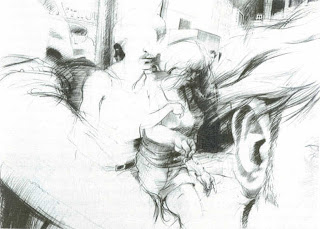I know class was long and jam-packed, but you've already learned some fundamental points about drawing that will be important to keep in mind as we continue working towards actually painting the figure. Don't forget that a drawing should start at your FEET, and the only way to truly translate what you are seeing from real world into two dimensions is to essentially shut off your brain. You don't want your brain to interfere by naming every object you are seeing; rather, you are trying to identify both positive and negative shapes.
Andres Zorn "The Toast"
Notice the compositional decisions that Zorn has made -- the large, mostly dark figure in the foreground is balanced by a large white negative space in the upper right hand corner, activating both the areas of detail and "not-detail." The figures in the background also help to draw in the viewer with direct eye contact.
David Hockney "Henry in Candlelight"
Hockney creates a focal point, the figure's head, by treating the face with more detail than any other part of the body and through the strong contrast of the light tones against the small area of darkness. This visual anomaly creates a point of focus.
Willem de Kooning "Woman"
De Kooning's piece contains much more movement and energy, but even sections of this drawing create the same visual anomaly present in Hockney's piece. The facial features demonstrate a slowness not present anywhere else, inviting the viewer to spend more time with it.
Edward Hopper "East Side Interior"
Hopper is great to look at in terms of value and contrast. He simplifies light and shadow into geometric shapes that create a dynamic composition and relay a sense of longing.
Robert Birmelin "The City Crowd, the Ear"
Don't forget to keep in mind using an interesting point of view, playing with focus and cropping the picture plane to create a certain mood or atmosphere. Birmelin's drawing leaves the viewer feeling tense and uncomfortable. He merely suggests the figures and landscape and yet our brains fill in the rest and understand the setting completely.
Caravaggio "The Sacrifice of Isaac"
This painting is a great reference when you all begin your (giant!) self portraits. Before Caravaggio painted in all of the details, he planned out a composition of positive and negative shapes that is active and exciting. The viewer's eye moves along the shape of the angel's arm and Isaac's body and up through the shape of Abraham's knife. The repetition of the oval (all of the figures' heads) creates a rhythm.







No comments:
Post a Comment